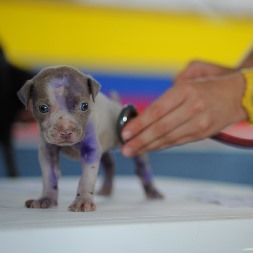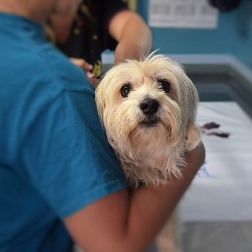How to Select a Vet Tech Program near Custer Montana
 Achieving your long term goal of working with and caring for pets by enrolling in a veterinary technician college near Custer MT could initially seem like a challenging undertaking. After all, you must search for and enroll in a program that will deliver the appropriate training to ensure that you can succeed as a vet tech. But just how do you go about evaluating and contrasting programs so that you can make the correct selection? Many potential students begin their due diligence process by searching for campuses that are close to their residences. Once they have located some area schools, they ascertain which ones have the most affordable tuition and hone in on those. Although location and cost are significant factors when evaluating veterinary technician schools, they are by no means the only critical ones when making your evaluations. Qualifiers such as internship programs and accreditation need to be considered as well. The main idea is that there are questions you need to be asking the vet technician schools you are considering before you make an ultimate choice. We have provided several within this article in order to help get you started, but before we discuss them we’ll discuss the varied responsibilities of veterinary technicians and the training alternatives available.
Achieving your long term goal of working with and caring for pets by enrolling in a veterinary technician college near Custer MT could initially seem like a challenging undertaking. After all, you must search for and enroll in a program that will deliver the appropriate training to ensure that you can succeed as a vet tech. But just how do you go about evaluating and contrasting programs so that you can make the correct selection? Many potential students begin their due diligence process by searching for campuses that are close to their residences. Once they have located some area schools, they ascertain which ones have the most affordable tuition and hone in on those. Although location and cost are significant factors when evaluating veterinary technician schools, they are by no means the only critical ones when making your evaluations. Qualifiers such as internship programs and accreditation need to be considered as well. The main idea is that there are questions you need to be asking the vet technician schools you are considering before you make an ultimate choice. We have provided several within this article in order to help get you started, but before we discuss them we’ll discuss the varied responsibilities of veterinary technicians and the training alternatives available.
The Job of a Vet Tech in Custer MT
 Among the first decisions that you will need to make is if you desire to train as a veterinary assistant, technician or technologist. Part of your decision might be dependent on the amount of time and money that you have to devote to your training, but the primary factor will undoubtedly be which specialty appeals to you the most. What technicians and assistants share in common is that they both work under the immediate supervision of a practicing and licensed veterinarian. And even though there are a number of functions that they can perform within the Custer MT veterinary clinic or hospital, they can’t prescribe medications, diagnose health issues, or conduct surgical procedures. In those areas they can only furnish support to a licensed vet. There are technicians and technologists that work away from the standard veterinarian practice, for instance for zoos, animal shelters or police departments. Let’s take a look at the duties and education prerequisites for each specialization.
Among the first decisions that you will need to make is if you desire to train as a veterinary assistant, technician or technologist. Part of your decision might be dependent on the amount of time and money that you have to devote to your training, but the primary factor will undoubtedly be which specialty appeals to you the most. What technicians and assistants share in common is that they both work under the immediate supervision of a practicing and licensed veterinarian. And even though there are a number of functions that they can perform within the Custer MT veterinary clinic or hospital, they can’t prescribe medications, diagnose health issues, or conduct surgical procedures. In those areas they can only furnish support to a licensed vet. There are technicians and technologists that work away from the standard veterinarian practice, for instance for zoos, animal shelters or police departments. Let’s take a look at the duties and education prerequisites for each specialization.
- Vet Assistants in almost all instances will have undergone a structured training program, either as an intern or apprentice in a practice, or by finishing a certificate program at a vocational school or community college. As the name implies, their job function is to assist the vets and vet techs in the completion of their duties. Normally they are not associated with more complex tasks, such as assisting with surgeries. Some of their usual duties may include working at the front desk, preparing and cleaning examination rooms and equipment, or handling pets during exams.
- Vet Technicians undergo more extensive training compared to assistants and generally obtain a two year Associate Degree, ideally from an American Veterinary Medical Association (AVMA) accredited program. They are in a sense the veterinarian counterparts of medical nurses, since their basic job duty is to assist veterinarians with diagnosing and treating animal patients. Where they stand apart from vet assistants is that they are included in more complicated activities, such as assisting with surgical procedures or providing medication. All states presently require vet technicians pass a credentialing exam for either registration, certification or licensing.
- Vet Technologists are comparable to vet techs and basically carry out the same work functions. They are required to earn a Bachelor’s Degree in veterinary technology, which typically takes 4 years to complete. So the only real difference between a vet technologist and a technician is the technologist’s more advanced level of education. But with an advanced degree comes more career options, higher salaries and possible management positions. They are also mandated to pass a credentialing exam for either certification, registration or licensing.
Veterinary techs and technologists may specialize in areas such as internal medicine, anesthesia or emergency care. Some may obtain certification from the American Association for Laboratory Animal Science (AALAS) to work in Custer MT labs or research facilities as well.
Veterinary Technician Online Programs Offered in Custer
 An approach that may be a solution for those with a busy lifestyle or who are working full time while attending vet college is to enroll in an online program. Since the classes are provided over the internet, students can study on their own timetable wherever a computer is accessible. The educational program is taught using several venues, including slide shows, videos and live streaming webinars. And since most veterinary tech and technologist degrees require practical training, that segment can typically be completed as an internship or work study program at a local Custer MT veterinary practice or hospital. Distance learning, as it is also called, may in some instances lower the cost of your education. Tuition and supplementary expenses, such as for commuting and study materials, may be more affordable compared to more traditional classroom courses. Just make sure that the online school that you enroll in is accredited, either by the AVMA or another nationally certified accrediting organization. With the online classes and the practical training, everything is included for a comprehensive education. So if you are dedicated enough to learn in this more independent fashion, an online vet tech program may be the ideal choice for you.
An approach that may be a solution for those with a busy lifestyle or who are working full time while attending vet college is to enroll in an online program. Since the classes are provided over the internet, students can study on their own timetable wherever a computer is accessible. The educational program is taught using several venues, including slide shows, videos and live streaming webinars. And since most veterinary tech and technologist degrees require practical training, that segment can typically be completed as an internship or work study program at a local Custer MT veterinary practice or hospital. Distance learning, as it is also called, may in some instances lower the cost of your education. Tuition and supplementary expenses, such as for commuting and study materials, may be more affordable compared to more traditional classroom courses. Just make sure that the online school that you enroll in is accredited, either by the AVMA or another nationally certified accrediting organization. With the online classes and the practical training, everything is included for a comprehensive education. So if you are dedicated enough to learn in this more independent fashion, an online vet tech program may be the ideal choice for you.
What to Ask Custer MT Vet Tech Programs
 At this point you should have selected which veterinary degree that you want to obtain, and if you want to study online or attend a college on campus. Since there are a large number of veterinarian community colleges, vocational and trade schools in the Custer MT area and across the Country, you must ask some qualifying questions in order to narrow down your list of alternatives. As we pointed out in our opening, many future students start by prioritizing location and the cost of tuition. But we have previously pointed out other essential qualifiers, for instance internship programs and accreditation. And of course you need to enroll in a program that offers the degree and specialty that you are interested in. These and other qualifications are covered in the checklist of questions that you need to ask the veterinary technician schools that you are reviewing.
At this point you should have selected which veterinary degree that you want to obtain, and if you want to study online or attend a college on campus. Since there are a large number of veterinarian community colleges, vocational and trade schools in the Custer MT area and across the Country, you must ask some qualifying questions in order to narrow down your list of alternatives. As we pointed out in our opening, many future students start by prioritizing location and the cost of tuition. But we have previously pointed out other essential qualifiers, for instance internship programs and accreditation. And of course you need to enroll in a program that offers the degree and specialty that you are interested in. These and other qualifications are covered in the checklist of questions that you need to ask the veterinary technician schools that you are reviewing.
Is the Veterinary College Accredited? It’s essential that you verify that the vet tech program you enroll in is accredited by a regional or national accrediting agency. As earlier discussed, among the most highly respected is the American Veterinary Medical Association (AVMA). Trade schools and colleges that are accredited by the AVMA have undergone a rigorous review process that verifies you will receive a quality education. Also, accreditation is important if you are requesting a student loan or financial aid, since numerous programs are not offered for non-accredited programs. And finally, having a degree or certificate from an accredited college is in many cases a prerequisite for employment for a number of Custer MT area vet practices and hospitals.
What is the College’s Reputation? The veterinary college or vocational school and program you choose should have an excellent reputation within the vet field. You can initiate your due diligence by asking the colleges you are looking at for testimonials from the employers in their job assistance network. Other tips include looking on online school rating websites and checking with the school’s accrediting agencies as well. You can ask the Montana school licensing authority if there have been any grievances or violations involving your specific schools. As a final pointer, phone some Custer MT vet clinics that you may want to work for after you receive your training. Ask what they think about your school choices. They might even recommend one or more colleges not on your list.
Are there Internship Programs? The most effective means to get practical hands on experience as a vet tech is to work in a clinical setting. Ask if the colleges you are looking at have internship programs established with Custer MT veterinarians, vet hospitals or practices. The majority of veterinary medicine programs mandate practical training and many furnish it through internships. Not only will the experience be beneficial relative to the practical training, but an internship may also help build associations in the local veterinarian community and aid in the search for a position after graduation.
Is Job Assistance Provided? Searching for a job after graduating from a veterinary technician program may be challenging without the help of a job placement program. First, ask what the graduation rates are for the schools you are considering. A low rate could suggest that the teachers were ineffective at teaching the syllabus or that some students were unhappy with the program and dropped out. Next, confirm that the colleges have a job assistance program and ask what their placement rates are. A high placement rate may mean that the school has an exceptional reputation within the Custer MT veterinary community and has a considerable network of contacts for student placements. A lower rate may indicate that the training is not well regarded by employers or that the job placement program is ineffective at placing students.
How Large are the Classes? If the classes are larger sized, you probably will receive little or no one-on-one instruction from the teachers. Solicit from the Custer MT programs you are looking at what their classroom teacher to student ratios are. You may also decide to attend a couple of classes (if practical) to observe the interaction between students and teachers. Get evaluations from students relating to the quality of instruction. Also, speak with the teachers and determine what their qualifications are as well as their methods of teaching.
Where is the College Located? Yes, we already covered location, but there are a few more points to make on the topic. If you are going to drive to your veterinary technician classes from your Custer MT home, you have to confirm that the commuting time is compatible with your schedule. For instance, driving during the weekend to investigate the route won’t be the same as the drive during rush hour traffic, particularly if the school is located in or close by a larger city. Also, if you do choose to attend a college in another state or even outside of your County of residence, there may be higher tuition fees particularly for community and state colleges. On the other hand, taking classes online could be an option that will give you more flexibility and reduce the necessity for travel.
Do the Classes Fit Your Schedule? And finally, it’s essential that you determine if the veterinarian programs you are exploring offer class times that are sufficiently flexible to accommodate your schedule. For example, many students continue working full time and can only attend classes on the weekends or at night near Custer MT. Others may only be able to attend classes in the morning or later in the afternoon. Make sure that the class times you require are available prior to enrolling. In addition, determine if you can make-up classes that you might miss because of work, illness or family emergencies. You may discover that an online program is the best solution to fit your vet education into your hectic life.
Enrolling in a Vet Tech School near Custer MT?
If you have decided to attend a Veterinary Technician Program in the Custer Montana area, then you may find the following information about the location of your school campus interesting and informing.
George Armstrong Custer
George Armstrong Custer (December 5, 1839 – June 25, 1876) was a United States Army officer and cavalry commander in the American Civil War and the American Indian Wars. Raised in Michigan and Ohio, Custer was admitted to West Point in 1857, where he graduated last in his class in 1861. With the outbreak of the Civil War, Custer was called to serve with the Union Army.
Custer developed a strong reputation during the Civil War. He participated in the first major engagement, the First Battle of Bull Run on July 21, 1861, near Washington, D.C. His association with several important officers helped his career as did his success as a highly effective cavalry commander. Custer was brevetted to brigadier general at age 23, less than a week before the Battle of Gettysburg, where he personally led cavalry charges that prevented Confederate cavalry from attacking the Union rear in support of Pickett's Charge. He was wounded in the Battle of Culpeper Court House in Virginia on September 13, 1863. In 1864, Custer was awarded another star and brevetted to major general rank. At the conclusion of the Appomattox Campaign, in which he and his troops played a decisive role, Custer was present at General Robert E. Lee's surrender to General Ulysses S. Grant, on April 9, 1865.
After the Civil War, Custer remained a major general in the United States Volunteers until they were mustered out in February 1866. He reverted to his permanent rank of captain and was appointed a lieutenant colonel in the 7th Cavalry Regiment in July 1866. He was dispatched to the west in 1867 to fight in the American Indian Wars. On June 25, 1876, while leading the 7th Cavalry Regiment at the Battle of the Little Bighorn in Montana Territory against a coalition of Native American tribes, he and all of his detachment—which included two of his brothers—were killed. The battle is popularly known in American history as "Custer's Last Stand."
Select the Right Vet Tech Program near Custer MT
 Picking the ideal vet tech college is a critical first step to beginning a fulfilling career delivering care and treatment for pets and livestock. Potential students looking into vet tech schools must make their determination based on several key issues. Veterinary technicians and technologists are employed in vet clinics, animal hospitals and animal shelters. They usually take on administrative duties and support the veterinarian with the animal patients as needed. As we have discussed, it’s imperative that you select a veterinary medicine program that is both accredited and has an outstanding reputation within the profession. This goes for online vet tech colleges as well. By asking the questions included in our checklist for evaluating schools, you will be able to reduce your alternatives so that you can make your final decision. And by choosing the right program, you can accomplish your goal of becoming a vet tech in Custer MT.
Picking the ideal vet tech college is a critical first step to beginning a fulfilling career delivering care and treatment for pets and livestock. Potential students looking into vet tech schools must make their determination based on several key issues. Veterinary technicians and technologists are employed in vet clinics, animal hospitals and animal shelters. They usually take on administrative duties and support the veterinarian with the animal patients as needed. As we have discussed, it’s imperative that you select a veterinary medicine program that is both accredited and has an outstanding reputation within the profession. This goes for online vet tech colleges as well. By asking the questions included in our checklist for evaluating schools, you will be able to reduce your alternatives so that you can make your final decision. And by choosing the right program, you can accomplish your goal of becoming a vet tech in Custer MT.
Other Doggone Good Cities in Montana
